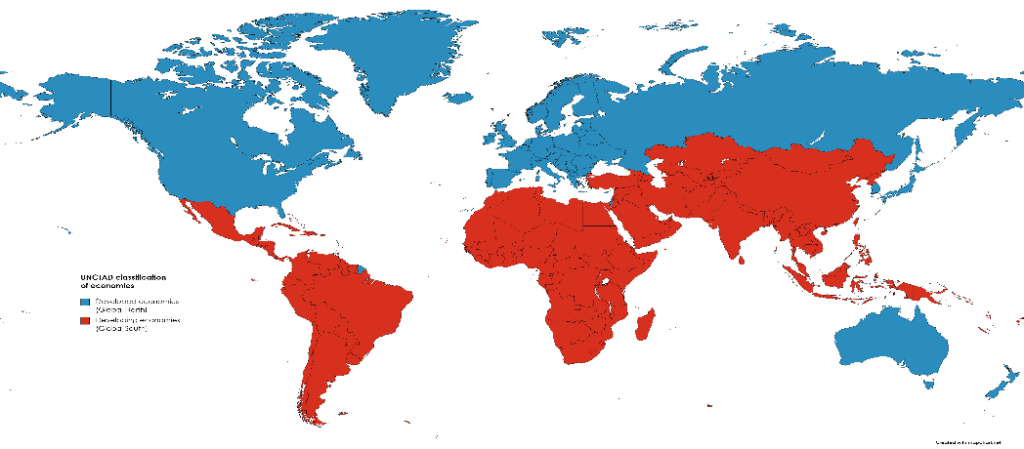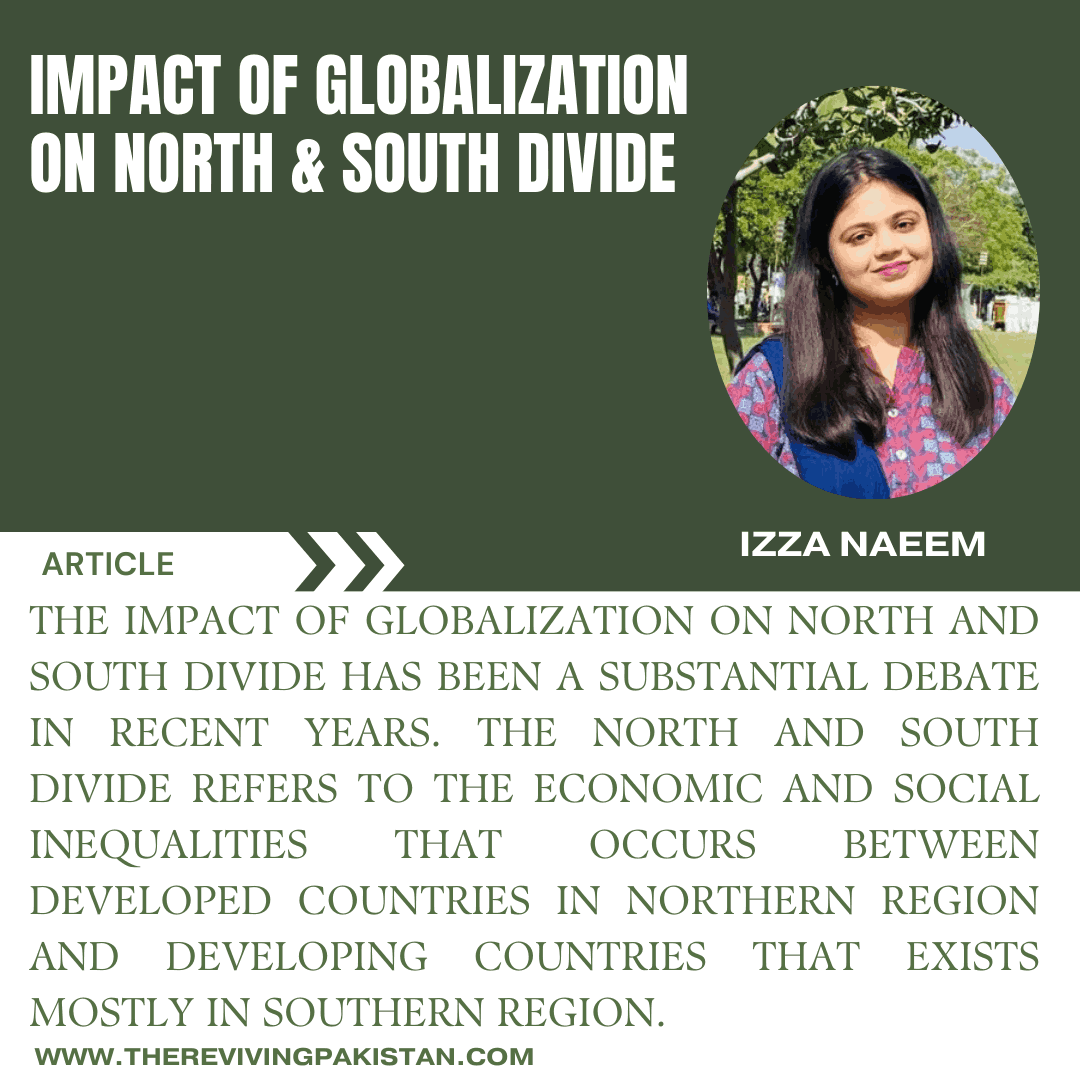About the Author(s)

Izza Naeem
The author is pursuing a Bachelor’s degree in International Relations at the University of Management and Technology in Lahore. Reading books has always been a habit of hers. She believes reading can help you write and discover what resonates with you.
Abstract:
The impact of globalization on the North and South divide has been a substantial debate in recent years. The North and South divide refers to the economic and social inequalities between developed countries in the Northern region and developing countries that exist primarily in the Southern region. The North is taken to include technologically advanced, high-per capita income, and national political economies. The South described those countries as having a high poverty level and a shallow level of industrialization. The increasing interrelation of economies, technology, and communication characterizes globalization. Globalization has had mixed effects on the different parts of the region. It has the potential to encourage financial growth in one region; however, it can also lead to enlarged inequality in the other parts of the area.
Keywords: Globalization, North, South
Introduction:
The North-South divide is a socio-economic division of the earth popularized in the late 20th century or the early 21st century. The North is mostly associated with the Western world, while the South largely agrees with developing countries (previously called ‘Third World’ countries) and the Eastern world. The idea of organizing the countries by their evolving and economic status began during the Cold War with the arrangements of the East and West. The Soviet Union and China denoted the East. Meanwhile, the United States and its allies (the UK and France) represented the West. The “Third World countries” were first used in an article inscribed by Alfred Sauvy named “Trois Mondes, Une Planète”. The North-South economic inequality stems from colonialism and inadequate power dynamic forces that have formed global economic relations for centuries. (Davis, 2012)
The Global North, comprising Northern America, Europe, and certain Oceanic and Asian countries, has generally benefitted from globalization. On the other hand, the Global South, based on countries like Latin America, Africa, and certain Asian countries, has faced unique challenges in the contemporary globalized world.
Research methodology:
Research approach: This research adopts a qualitative approach, mostly relying on secondary resources and methods to comprehensively explain the impact of globalization on the North-South divide and allow the understanding of this topic from multiple perspectives.
Qualitative data collection: Examining the specific case studies of the regions within the Northern region, such as Germany and France, and Southeareasons, such as Sudan and Somalia, to analyze the differential effects of globalization on development and inequality.
Sampling: Case studies are selected based on specific geographical location and developmental status to capture a range of outcomes.
Research Question:
To what extent has globalization impacted the economic disparities between the Global North and Global South?
Explanation:
Globalization has had intricate effects on economic disparities between the Global North and Global South. On one hand, it has the potential to reduce disparities by endorsing economic growth and integration in developing countries. For instance, increased foreign direct investment (FDI) and access to global markets can provide prospects for technological transfer, job creation, and improved living standards (Mathur, 2009).
In the North, there are technological hubs, international corporations, and advanced military equipment, providing many facilities to the citizens to showcase their talent related to the area of their interest. Recently, immigration issues have emerged in developed countries, mainly in Europe. According to the World Migration Report, migration from Northern America and Europe drove much of an increase in the number of migrants, reaching a total of more than 46 million extra-regional migrants in 2020. (Migration and Migrants: Regional Dimensions and Developments, 2020)

Globalization can also worsen the disparities due to numerous factors. Firstly, the benefits of globalization are not evenly disseminated. Developing countries or certain divisions within developing countries may excessively benefit, while others may leave behind. Regarding labour markets, jobs often come with low wages and poor working conditions in the southern part. Individuals may suffer from malnutrition and an unhygienic environment that makes it difficult for them to live an everyday life. In remote areas of South Africa, hospitals and educational institutions are unavailable. People have to walk miles away barefooted from their homes to access basic needs like food and water. The majority of the people live below the poverty line. Steps needed to be taken by the government of that particular state by building partnerships with other countries and international organizations like UNICEF, WHO, etc., to narrow this economic divide.
Factors contributing to the narrowing of this divide:
Collaborative efforts that foster economic growth and high-tech transfer can help developing countries achieve more equitable and inclusive growth. Institutional quality, integration into global markets, and financial stability are some key factors that contribute mainly to narrowing the divide. Moreover, transnational policies and agreements, such as those promoting trade, can influence the extent to which globalization can help reduce economic disparities. (Rafael X. Reuveny, 2007)
Analysis:
Understanding the influence of globalization on the different regions of the world requires an in-depth study of how globalization establishes inversely in the region. This research seems to be approaching from a theoretical framework of WORLD SYSTEM THEORY, as proposed by Immanuel Wallerstein. This theory suggests that the global capitalist system separates the country into the core (North) and the periphery (South) nations based on their economic participation. Dependency theorists suggest that the rise of capitalism creates a hierarchical world order in which the South broadly provides the North with cheap labour, raw materials and market opportunities. Additionally, globalization has led to the destruction of some local cultures. In the South, there is still a struggle to preserve their culture. Some communities see globalization as an opportunity, while others see it as a menace to their legacy.
Recommendations:
- Prioritize investments in the healthcare and education sectors in developing states.
- Encourage reasonable trade policies that ensure the interests of producers and workers in the South.
- Instead of entirely relying on exchanges with the North, Southern countries should strengthen their bonds with neighbouring countries to enhance cooperation.
- Promote multilateral cooperation to address the common challenges arising from globalization.
Conclusion:
In conclusion, the research on the impact of globalization on the North and South divide highlights the phenomenon’s complexity. Every picture has a positive and negative side of the story. Globalization undoubtedly reshaped the economies, societies and cultures worldwide, but its effects have been unevenly distributed, as mentioned above, intensifying the inequalities between the North and the South. While some economies have faced rapid growth and technological transference, others have faced marginalization and exploitation. Certain factors like access to technology and prioritizing investments can help bridge the gap between the Northern and Southern regions of the globe.
References:
Davis, T. W. (2012). Globalisation and the North/South Divide: An Overview . In R. Pettman, Handbook on International Political Economy (p. 480).
Mathur, A. (2009). FRACTURED GLOBALIZATION : NORTH SOUTH DIVIDE OVER HUMAN RIGHTS AND ENVIRONMENT, 9-20.
(2020). Migration and Migrants: Regional Dimensions and Developments.
Rafael X. Reuveny, W. R. (2007). The North–South Divide and International Studies: A Symposium, 556-564.

